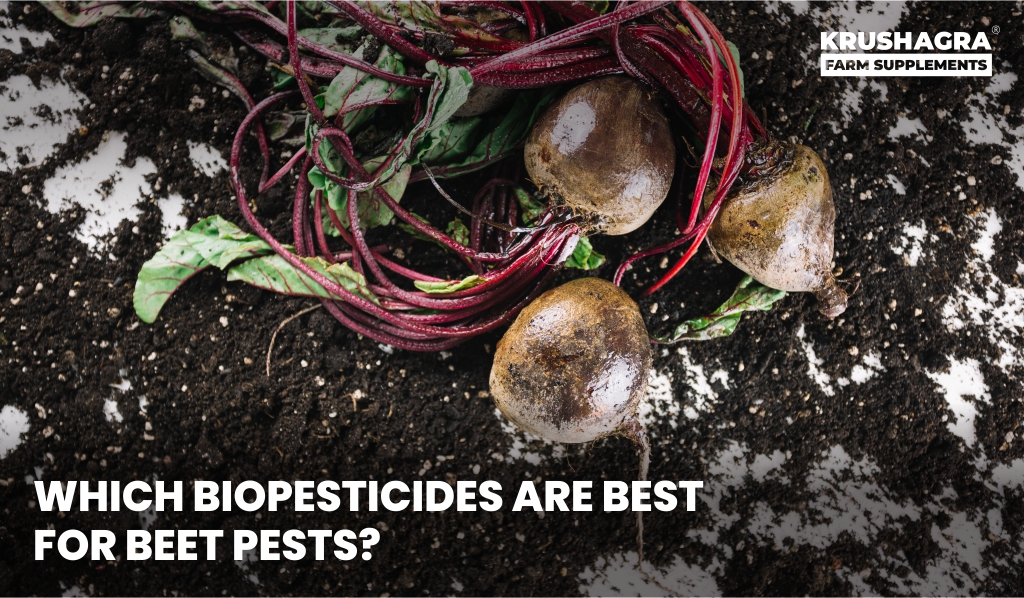Beet crops, including sugar beet, table beet, and fodder beet, are a valuable resource for agriculture, contributing to global food, fodder, and sugar industries.
However, pests like aphids, beetles, nematodes, and caterpillars pose significant threats to beet production. With growing awareness of sustainable farming, biopesticides have emerged as an eco-friendly solution to combat beet pests effectively.
This blog delves into the world of biopesticides, highlighting their benefits, mechanisms, and the top biopesticides for controlling beet pests.
Understanding Biopesticides and Their Benefits
Biopesticides are naturally derived pest control agents made from living organisms or their by-products. These include microbial pesticides, botanical extracts, and biochemical compounds like pheromones. The advantages of biopesticides over synthetic pesticides include:
- Eco-friendliness: Minimal impact on non-target organisms and the environment.
- Safety: Reduced toxicity for humans, animals, and pollinators like bees.
- Resistance Management: Lower chances of pests developing resistance.
- Sustainability: Supports organic farming and sustainable agricultural practices.
Common Beet Pests and Their Challenges
Effective pest control starts with understanding the threats. Some of the major beet pests include:
- Aphids: These sap-sucking insects weaken plants and transmit viral diseases.
- Beet Leaf Miners: Larvae burrow through leaves, reducing photosynthetic capacity.
- Flea Beetles: Adults chew holes in leaves, stunting plant growth.
- Nematodes: Root-feeding nematodes damage beets below ground, leading to poor yields.
- Armyworms and Cutworms: These caterpillars defoliate plants and damage roots.
Top Biopesticides for Beet Pests
1. Bacillus thuringiensis (Bt)
- Target Pests: Caterpillars, including armyworms and cutworms.
- Mechanism: Produces toxins that paralyze and kill the larvae upon ingestion.
- Application: Bt sprays can be applied directly to beet leaves for targeted pest control.
- Benefits: Safe for beneficial insects and non-toxic to humans.
2. Beauveria bassiana
- Target Pests: Aphids, beetles, and other soft-bodied insects.
- Mechanism: A fungal pathogen that infects insects, causing death within days.
- Application: Applied as a foliar spray during active pest infestation.
- Benefits: Works as a natural population suppressant and prevents resistance buildup.
3. Neem-Based Biopesticides
- Target Pests: Aphids, nematodes, and leaf miners.
- Mechanism: Neem extracts contain azadirachtin, which disrupts insect growth, feeding, and reproduction.
- Application: Sprays or soil drenches ensure protection against various beet pests.
- Benefits: Biodegradable and safe for non-target organisms.
4. Paecilomyces lilacinus
- Target Pests: Root-knot nematodes and soil-borne pests.
- Mechanism: This fungus parasitizes nematode eggs and juveniles, reducing populations.
- Application: Applied to the soil before planting for preventative control.
- Benefits: Improves soil health while targeting nematodes naturally.
5. Spinosad
- Target Pests: Beet leaf miners, flea beetles, and caterpillars.
- Mechanism: Derived from bacterial fermentation, it affects the nervous system of pests, leading to paralysis and death.
- Application: Used as a foliar spray for fast-acting pest control.
- Benefits: Quick degradation in the environment and low toxicity to beneficial insects.
6. Entomopathogenic Nematodes
- Target Pests: Soil-dwelling pests like cutworms and root maggots.
- Mechanism: These microscopic worms enter the host and release symbiotic bacteria that kill the pest.
- Application: Applied to the soil as a drench or spray.
- Benefits: Targets pests in hard-to-reach soil zones without harming crops.
Best Practices for Using Biopesticides
To maximize the effectiveness of biopesticides, follow these tips:
- Pest Identification: Ensure accurate identification of pests before applying biopesticides.
- Timing: Apply during early pest infestation or specific pest life stages, as biopesticides are more effective on immature pests.
- Coverage: Use sprayers to ensure even application on leaves, stems, or soil, depending on the pest’s location.
- Environmental Factors: Avoid application during extreme temperatures or rain, as these conditions can reduce efficacy.
- Storage: Store biopesticides in a cool, dry place to maintain their potency.
Combining Biopesticides with Integrated Pest Management (IPM)
Biopesticides work best when integrated into an IPM approach. This involves:
- Crop Rotation: Disrupts pest life cycles and reduces infestations.
- Natural Predators: Encourage beneficial insects like ladybugs and lacewings.
- Resistant Varieties: Use pest-resistant beet varieties to reduce susceptibility.
- Monitoring: Regular pest scouting helps detect early infestations.
Integrated Pest Management (IPM) is a sustainable approach to pest control that combines biological, cultural, mechanical, and chemical methods to minimize pest damage while protecting the environment.
Biopesticides, derived from natural sources such as microorganisms, plant extracts, or beneficial organisms, play a crucial role in IPM systems, offering targeted and eco-friendly pest control solutions.
When integrated into any IPM strategy, biopesticides enhance pest control efficacy by reducing reliance on chemical pesticides, thus minimizing the risk of pesticide resistance and environmental harm.
For instance, microbial biopesticides like Bacillus thuringiensis (Bt) effectively target specific pests, such as caterpillars, without harming beneficial insects or non-target organisms.
Similarly, neem-based biopesticides disrupt the life cycles of aphids and nematodes, providing both preventive and curative control.
The use of biopesticides in IPM also complements cultural and mechanical practices. For example, crop rotation can break pest life cycles, while soil applications of biopesticides like Paecilomyces lilacinus help suppress soil-borne pests, enhancing the effectiveness of these strategies.
Additionally, biopesticides can be combined with natural predators, such as ladybugs or lacewings, to provide comprehensive pest suppression.
To maximize the benefits of biopesticides in IPM, careful monitoring and pest identification are essential. Applying biopesticides at the right time—when pests are in their most vulnerable stages—ensures optimal effectiveness.
Regular pest scouting and using biopesticides as part of a broader, integrated approach help reduce pest populations sustainably while maintaining crop health.
By combining biopesticides with other IPM components, farmers can achieve effective pest control while preserving soil health, biodiversity, and ecological balance.
This integrated approach not only boosts crop yields but also aligns with the principles of sustainable agriculture, ensuring long-term agricultural productivity.
Environmental and Economic Benefits of Biopesticides
Adopting biopesticides for beet pest control offers dual benefits:
- Environmental Protection: Reduces chemical pesticide residues in soil and water, preserving biodiversity.
- Economic Viability: Lower long-term costs due to sustainable pest control and improved crop quality, making biopesticides a cost-effective choice for farmers.
Conclusion
Biopesticides are an excellent solution for controlling beet pests while promoting sustainable agriculture. From Bacillus thuringiensis to neem-based formulations, these natural pest control agents offer targeted action with minimal environmental impact.
By combining biopesticides with integrated pest management practices, farmers can ensure healthy, high-yield beet crops without compromising the ecosystem.
For a greener future, choosing biopesticides is not just a trend but a necessity.
Frequently Asked Questions
What are biopesticides?
Biopesticides are pest control agents derived from natural materials like microbes, plants, or beneficial organisms. They are eco-friendly and target specific pests without harming the environment.
Which biopesticides are best for beet aphids?
Neem-based biopesticides and Beauveria bassiana are highly effective against aphids. Neem disrupts their feeding and reproduction, while Beauveria infects and kills them.
Can biopesticides control soil-dwelling beet pests?
Yes, biopesticides like entomopathogenic nematodes and Paecilomyces lilacinus effectively control soil pests like nematodes, root maggots, and cutworms.
Are biopesticides safe for beneficial insects?
Most biopesticides, such as Bacillus thuringiensis and spinosad, are safe for beneficial insects like bees and ladybugs when applied correctly.
How should biopesticides be applied?
Biopesticides can be applied as foliar sprays, soil drenches, or seed treatments. Ensure even coverage and follow label instructions for the best results.






